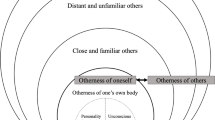Abstract
The concept of human relatedness was reexamined in the context of a standardized evaluation of 55 boys and 13 girls referred with a diagnosis of childhood psychosis. Human relatedness was hypothesized to be a multidimensional complex construct which could be analyzed in terms of simpler, more basic functions. All children were evaluated on a 14-point diagnostic scale. Analysis of diagnostic data generated three factors, one of which comprised a cluster of variables representing a measure of human relatedness and various perceptual functions. The hypothesis was supported by factor loadings. Also, a multiple regression analysis indicated that most of the variance in human relatedness could be accounted for by perceptual variables. It is suggested that impairment of human relatedness is largely due to impaired perceptual functions, and that much inappropriate maternal behavior is in response to such functions.
Similar content being viewed by others
References
Bettelheim, B.The empty fortress: Infantile autism and the birth of the self. New York: Free Press, 1967.
Bowlby, J.Attachment and loss. Vol. 1. New York: Basic Books, 1969.
Casler, L. Maternal deprivation: A critical review of the literature.Monograph of Society for Research in Child Development, 1961,26, 80.
Creak, M. Schizophrenic syndrome in childhood: Further progress report of a working party.Developmental Medicine and Child Neurology, 1964,6, 530–535.
Goldfarb, W. Receptor preferences in schizophrenic children.Archives of Neurology and Psychiatry, 1956,76, 643–652.
Hollingshead, A.Two factor index of social position. New Haven, Conn.. Author, 1965.
Hutt, C. H., & Hutt, S. J. Biological studies of autism.Journal of Special Education, 1970,3(1), 1–11.
Kanner, L. Autistic disturbances of affective contact.Nervous Child, 1943,2, 217–250.
Lovaas, O. I., Freitag, G., Kender, M. I., Rabenstein, B. D., Schaeffer, B., & Simmons, J. Q. Establishment of social reinforcers in two schizophrenic children on the basis of food.Journal of Experimental Child Psychology, 1966,4, 109–125.
Mahler, M. S.On human symbiosis and the vicissitudes of individuation. New York: International Universities Press, 1970.
Nunnally, J. C.Psychometric theory. New York: McGraw-Hill, 1967.
Ornitz, E. M., & Ritvo, E. R. Perceptual inconstancy in early infantile autism.Archives of General Psychiatry, 1968,18, 79–98.
Prescott, J. W. Early somatosensory deprivation as an ontogenetic process in the abnormal development of the brain and behavior. In I. E. Goldsmith and J. Moore-Jankowski (Eds.),Medical primatology. New York: S. Karger, 1971, in press.
Rutter, M. Concepts of autism: A review of research.Journal of Child Psychology and Psychiatry, 1968,9, 1–25.
Schopler, E. Early infantile autism and receptor processes.Archives of General Psychiatry, 1965,13, 327–335.
Schopler, E. Parents of psychotic children as scapegoats. Paper presented at Symposium of the American Psychological Association, Washington, D. C., September, 1969.
Schopler, E., Brehm, S., Kinsbourne, M., & Reichler, R. J. Effect of treatment structure on development in autistic children.Archives of General Psychiatry, 1971,24, 415–421.
Schopler, E., & Loftin, J. Thought disorders in parents of psychotic children: A function of test anxiety.Archives of General Psychiatry, 1969,20, 174–181.
Schopler, E., & Reichler, R. J. Parents as cotherapists in the treatment of psychotic children.Journal of Autism and Childhood Schizophrenia, 1971,1(1), 87–102. (a)
Schopler, E., & Reichler, R. J. Psychobiological referents to the treatment of autism. In D. W. Churchill, G. D. Alpern, & M. K. DeMyer (Eds.),Infantile autism. Springfield, Ill.: Charles C Thomas, 1971. (b)
Schopler, E., & Reichler, R. J. Developmental therapy by parents with their own autistic child. In M. Rutter (Ed.),Infantile autism: Concepts, characteristics and treatment. London: Churchill, 1971, in press, (c)
Shaffer, H. R., & Emerson, R. E. The development of social attachments in infancy.Monograph of Society for Research in Child Development, 1964,29, 3.
Slukin, W.Imprinting and early learning. Chicago, Ill.: Aldine-Atherton, 1967.
Stern, D. N. Microanalysis of mother-infant interaction.Journal of American Academy of Child Psychiatry, 1971,10, 501–517.
Author information
Authors and Affiliations
Additional information
Supported in part by the National Institute of Mental Health Grant MH 15539. We gratefully acknowledge the statistical consultation of John Hawley, Psychometric Laboratory, University of North Carolina. Edwina Bentz and Laura Viernstein, Research Assistants in the Child Research Project, assisted in the collection and analysis of the data.
Rights and permissions
About this article
Cite this article
Reichler, R.J., Schopler, E. Observations on the nature of human relatedness. J Autism Dev Disord 1, 283–296 (1971). https://doi.org/10.1007/BF01557349
Issue Date:
DOI: https://doi.org/10.1007/BF01557349




